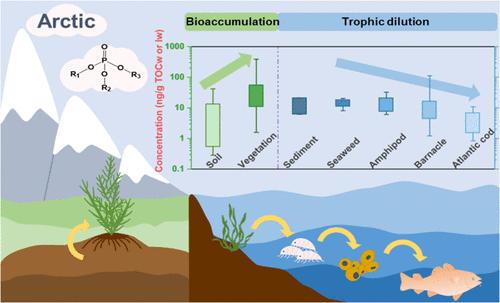北极陆地和底栖海洋生态系统有机磷酸酯(OPEs)的生物积累和营养转移
IF 11.3
1区 环境科学与生态学
Q1 ENGINEERING, ENVIRONMENTAL
引用次数: 0
摘要
在遥远的极地生态系统中,有机磷酸酯(OPEs)的日益流行引起了重大关注;然而,这些化合物在极地地区的生物积累和营养转移动力学仍然知之甚少。本研究调查了北极斯瓦尔巴群岛土壤、植被、海洋沉积物和生物群中OPEs的发生和分布。Σ10OPEs在北极陆地和底栖海洋基质中分别为1.12 ~ 236 ng/g干重(dw)和1.96 ~ 255 ng/g dw。三乙基磷酸(TEP)、三(1-氯-2-丙基)磷酸(TCIPP)、三(2-氯乙基)磷酸(TCEP)和三(2-丁氧乙基)磷酸(TBOEP)是所有样品的优势同源物。OPEs在陆地环境的土壤-植被系统中表现出生物积累,而在底栖海洋食物网中则出现了显著的营养稀释。有趣的是,对数辛醇-水分配系数(log KOW)与陆地环境中的对数转化生物浓度因子(BCFs)之间以及对数 KOW与底栖海洋食物网中的营养放大因子(TMFs)之间存在抛物线相关性,这表明具有中等亲脂性的同系物具有最高的生物积累潜力。本研究首次对北极生态系统中有机磷的生物积累和营养转移进行了全面评估,为极地地区有机磷的环境行为提供了重要见解。本文章由计算机程序翻译,如有差异,请以英文原文为准。

Bioaccumulation and Trophic Transfer of Organophosphate Esters (OPEs) in Arctic Terrestrial and Benthic Marine Ecosystems
The increasing prevalence of organophosphate esters (OPEs) in remote polar ecosystems has raised significant concerns; yet the bioaccumulation and trophic transfer dynamics of these compounds in polar regions remain poorly understood. This study investigated the occurrence and distribution of OPEs in soil, vegetation, marine sediment, and biota from Svalbard, Arctic. Σ10OPEs ranged from 1.12 to 236 ng/g dry weight (dw) and 1.96 to 255 ng/g dw in the Arctic terrestrial and benthic marine matrices, respectively. Triethyl phosphate (TEP), tris(1-chloro-2-propyl) phosphate (TCIPP), tris(2-chloroethyl) phosphate (TCEP), and tri-(2-butoxyethyl) phosphate (TBOEP) were the dominant congeners across all samples. OPEs exhibited bioaccumulation within the soil-vegetation system of the terrestrial environment, while significant trophic dilution occurred in the benthic marine food web. Interestingly, parabolic correlations were observed between log octanol–water partition coefficients (log KOW) and log-transformed bioconcentration factors (BCFs) in the terrestrial environment, as well as between log KOW and trophic magnification factors (TMFs) in the benthic marine food web, suggesting that congeners with moderate lipophilicity exhibit the highest potential for bioaccumulation. This study presents the first comprehensive assessment of the bioaccumulation and trophic transfer of OPEs in the Arctic ecosystem, providing critical insights into the environmental behaviors of OPEs in polar regions.
求助全文
通过发布文献求助,成功后即可免费获取论文全文。
去求助
来源期刊

环境科学与技术
环境科学-工程:环境
CiteScore
17.50
自引率
9.60%
发文量
12359
审稿时长
2.8 months
期刊介绍:
Environmental Science & Technology (ES&T) is a co-sponsored academic and technical magazine by the Hubei Provincial Environmental Protection Bureau and the Hubei Provincial Academy of Environmental Sciences.
Environmental Science & Technology (ES&T) holds the status of Chinese core journals, scientific papers source journals of China, Chinese Science Citation Database source journals, and Chinese Academic Journal Comprehensive Evaluation Database source journals. This publication focuses on the academic field of environmental protection, featuring articles related to environmental protection and technical advancements.
 求助内容:
求助内容: 应助结果提醒方式:
应助结果提醒方式:


